What the future holds for 3D Printing
Digital Esthetics talks to a variety of industry experts to find out how 3D printing has shifted the dental industry-and what it will do in the future.
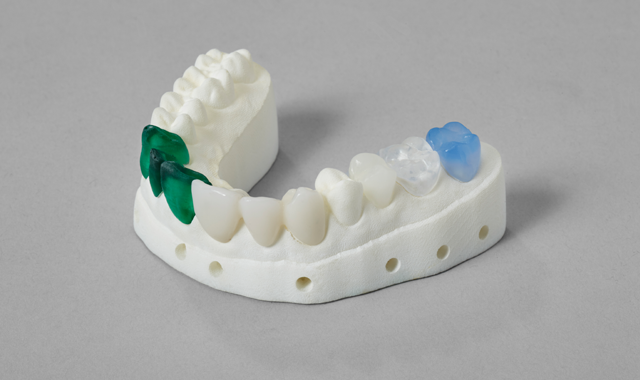
Fortunetellers have any number of schemes to predict the future. They might use tasseography (reading tea leaves); ceromancy (interpreting patterns in wax drippings); or even alectromancy (watching a rooster peck at grains).
But foretelling the future of 3D printing isn’t contingent on fringe chicanery. All it takes is the input of industry leaders-leaders who have seen where 3D printing has been; know where it is going; and-in some cases-are helping guide it.
The current state of 3D printing
Currently, 3D printers are added to a lab’s (or a doctor’s) CAD/CAM solution. That is, items that are normally sent to a mill or model room are sent to the 3D printer for model production or other production.
Where milling is a subtractive process (a block of material is sculpted), 3D printing is an additive process, meaning the 3D printer creates a product, layer by layer.
Currently, labs are limited in what 3D printers can produce.
“Everything is still model-based,” Jeff Youngerman, CDT, Western Account Manager for Stratasys, says. “Although there are many applications that go along with it, the 3D printer itself is going to print out a model. The only appliances that it can currently print out, at least in our world, is the surgical guide application. We can also do castable patterns.”
Bob Cohen, CDT, President of Custom Automated Prosthetics (CAP), observes that there are other devices that labs routinely fabricate.
“I don’t believe there is any one big indication that is pushing printing,” Cohen says. “However, the combination of all the following makes print technology viable for many labs:
- Crown and bridge models
- Ortho models
- Implant analog models
- Castable patterns
- Pressable patterns
- Surgical guides for implant placement
- Provisional restorations
- Bite appliances
- Ortho appliances
- Full dentures
- Custom trays
- Try-in bridges”
Some of these products, he notes, are specific to individual printers.
BEGO, which now has a desktop resin printer called the VARSEO, is also involved with metal 3D “printing” called selective laser melting (SLM). In this process, a laser is guided by the CAD model and layers of metal are added to the fabrication.
Nick Azzara, Chief Sales and Marketing Officer of BEGO USA, says, “We are really excited about resin printing. It offers great options to many solutions inconvenient to mill. We expect dramatic advancements continuing with resin printing in the very near future. As for SLM technology, while final restorations are not yet made, SLM can be used to produce select components (including copings for single units and frameworks for bridges), ready for porcelain application.
“Crowns and bridges have been the mainstay of SLM, and it’s been a productive technology,” he adds. “SLM gives labs the opportunity to work directly from an STL file to metal without investing, casting and some of the challenges that go with the lost-wax technique.”
In a clinical setting, some doctors include 3D printing as part of their armamentarium.
“We use two EnvisionTEC Vida printers for study models, implant surgical guides and the models for the guides,” implant dentist Dr. Justin Moody, DDS says. Dr. Moody is a client of EnvisionTEC.
Whether or not a 3D printer is physically in use at a clinic, more and more doctors are finding themselves as part of the 3D printing workflow, based on what technology they have chosen to invest in.
“That is being driven by intraoral scanners,” Chris Frye, Digital Technology Solutions Sales Manager and Dental Channel Sales Manager at Whip Mix, says. “The doctors are buying the digital scanners and they’re sending the digital files to the lab. So when you’ve got a digital impression, you don’t pour-up a model from a traditional impression. You’re printing the model from the digital impression that you’re getting from the doctors.”
Gazing into the crystal ball
The industry can expect to see important advancements in 3D printing within the next five years-maybe even sooner.
“Right now, with a lot of the 3D printing materials on the market, there is a lot of work that goes into the post processing,” Frye says. “The key will be printing the final restoration with a clean and easy post processing. That’s the end game for 3D printing in the dental industry.”
“In five years, we can hope to make final restorations on 3D printers,” Paul Dinh, Vice President of Products at ClearCorrect adds. “In 10 years, we may have plastics with different colors and strengths designed specifically for different appliances.”
Cohen expects developments, improving on what can already be achieved.
“In the short term we will have further advancements in dentures,” Cohen says. “I see composite resin materials coming first, likely in the next two years.”
Further, Frye expects greater adoption of 3D printing, based on existing technology acceptance.
“You’re seeing doctors buy intraoral scanners every day,” Frye says. “So for the next couple of years, you’ll see a lot of desktop printers or small printers coming out at a low price point for people to print models, and then of course there are resins that burnout, so people will print restorations to either be pressed or cast. Eventually we will print the final restoration. I wholeheartedly believe that.”
3D printing can provide stunning model results. (Photo courtesy of Stratasys)
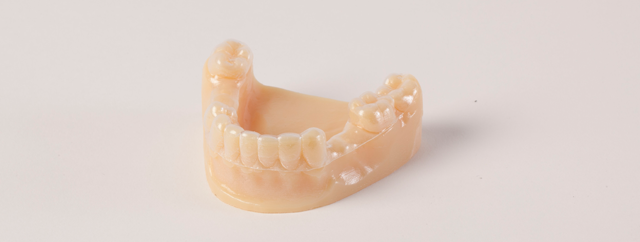
Ultimately, the next five years are likely to impress and amaze.
“This is what’s most exciting about additive manufacturing,” Youngerman says. “We are going to see all these applications everybody wants to see-final restorations, multiple colors being used, night guards, aligners-pretty much both ortho and crown and bridge applications, even removable applications like dentures. These are all things we’re hopefully going to see in the next five years.”
Futurecasting 15 years and beyond, Cohen anticipates improved integration with other digital devices to deliver restorations with new levels of function and esthetics.
“Longer term, I see print technology attaching to devices like the TRIOS intraoral scanner that takes both digital impressions and shades,” Cohen says. “I would expect the software to mirror an adjacent tooth form and color mapping to build an identical 3D replacement.”
Dinh also expects exceptional levels of form, function and esthetics.
“Hopefully in fifteen years, we can expect printing plastics will last longer, be lighter and be more esthetic,” Dinh says.
Patients will save money (or maybe they won’t …)
One would hope that along with these fantastic advancements would come cost savings to trickle down to the patient. Some agree with this assessment.
“Printing the final restoration will reduce many manufacturing steps, which will bring the cost down,” Dinh says.
Dr. Moody agrees, and notes that the cheaper cost will come with some benefits that are big selling points of 3D printing.
“It should not only make them more affordable but also quicker and, in many cases, the same day,” he says.
If the history of digital dentistry is any indication, Youngerman expects 3D printing and its benefits to follow a similar trajectory.
Multiple models can be made simultaneously, increasing efficiency. (Photo courtesy of Stratasys)
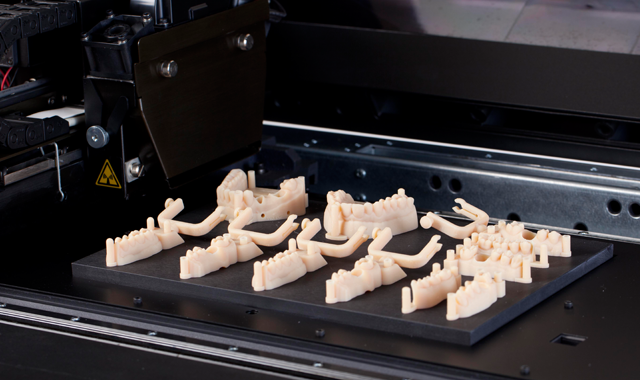
“I think anytime that you can mass-produce something and you can do it with much less labor,” Youngerman says, “it’s a natural progression of our industry. We see it with zirconia; we see it with the e.max. Everything had to be a layered solution, now everything can be a monolithic, and everything can be comfortably glazed and stained. The patient acceptance goes up, and of course, dentist acceptance goes up as well.”
But others don’t expect patients to see much in the way of savings.
“I don’t believe cost of care will go down,” Cohen observes. “Currently, many dentists are milling blocks in offices and many are upcharging the service, as it’s sold as having greater patient value, because it’s done in one appointment. Others charge the same as a lab restoration. I see printing as a more efficient, lower-cost alternative that will help labs and dentists control costs, but I do not see the savings being passed on to patients.”
Frye anticipates that patient cost will be driven by the industry.
“You would like to think so,” Frye says. “You would like to think it will open for everyone, but everything is so market-driven that I don’t know if that will help drive the price down or not.”
Making the impossible possible
While everyone seems to be eager to print long-term restorations for immediate use in the mouth, what other restorations-that might previously have been out-of-reach-will 3D printing make feasible?
“This is really a question about material science,” Cohen says. “It’s very difficult to know what’s being worked on, but looking at the exponential rate of technological development, the sky’s the limit.”
Whatever is made, Frye says just by virtue of the technology, we will be able to create for complex, functional restorations and devices.
“If you compare additive manufacturing versus subtractive manufacturing, anytime you’re building something up layer-by-layer, you’re going to be able to make something that’s easier to build than by using subtractive manufacturing, or reducing from a block of something,” he says.
In other cases, expect improvements on products that are already possible.
“A lot of companies are working on 3D printing of dentures,” says Dr. John Flucke, DDS, Technology Editor for Dental Products Report. “To the layperson, it seems like it ought to be pretty easy process. In reality, it is a difficult process. It really, truly is. It’s very, very precise, very unforgiving-you have to get it exactly right. And when you can eliminate things like impressions, and simply scan the tissues, and just like we do now with crowns, do digital impressions of the soft tissue, and then being able to, with equal precision, fabricate a denture that goes onto that, that’s going to be a really, really big deal.”
It’s not just restorations and prostheses that can benefit from 3D printing’s evolution. Surgical guides have already been easier to make and are more accessible to doctors. However, there is even more room for improvement.
“Right now, it’s estimated that 10 to 15 percent of all implant surgeries are done with some sort of a guide, yet with printers getting more affordable, more predictable, and guided surgery software becoming easier, we should absolutely see the cost of guides becoming more affordable and being done in a very quick, rapid way,” Azzara says. “I believe that guide use here in the U.S. is going to explode, as it should, and printing will play a huge role.”
Materials
While printing models and appliances are solid products, there is an ultimate product that everyone wants-final restorations that can go directly into the patient’s mouth. The biggest hurdle seems to be materials.
“Every manufacturer, ourselves included, are working on materials to do that,” Youngerman says. “There’s a lot to it. It’s not just getting the materials; it’s getting the right strength. It’s getting the FDA approval, going through the process where we can actually use it in a patient’s mouth safely. All of these materials now are resin-based materials, and there are a lot of limitations as far as what can stay in the mouth, long-term. It’s definitely not going to be in the next month or so, but within a short period of time-and I would leave that pretty vague. But in a short period of time I think we will see more materials that can actually be used and be approved for intraoral use.”
With so many varied components-both at the clinic and the lab-manufacturers are striving to find the right materials.
Just some of the 3D printing materials out there. (Photo courtesy of Whip Mix Corporation)
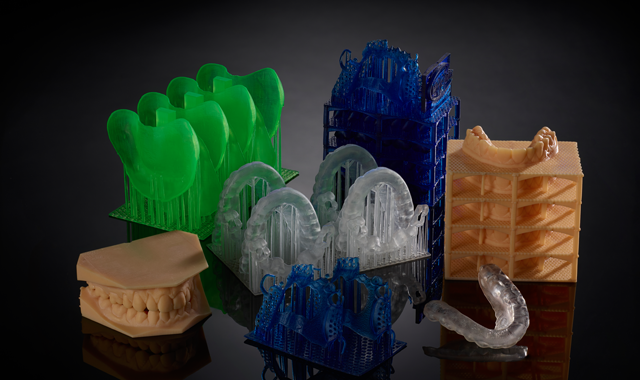
“Of course we want to develop stronger materials, materials that can go into the intraoral environment,” Youngerman says. “The problem with the current materials is through the access in the mouth and the warm environment and the wet environment, that the materials will eventually break down. Finding longer-term solutions for those kinds of materials, more durable materials, that’s really where the goal is, and to basically mimic the acrylics that are out there that are currently being used.”
Manufacturers aren’t just focused on the final restorations, but they do need to manage regulatory concerns, as well.
“3D print materials now available include metals, composites, plastic, food, biomaterials, paper and several others,” Cohen adds. “That said, the general categories are likely what we will see used in dental but need more research and development as well as FDA clearance for use intraorally.”
Frye notes that some European companies (he mentions WASP in Italy and Z3Dlab in France in particular) are striving to develop materials, not just for dental applications, but also for medical use. The enthusiasm for medical applications will no doubt spur progress for the dental world.
“You’ve got a lot of companies out there now working on materials that could be for the dental industry, printing out the final restoration,” Frye says. “All of these materials you’ll see used as prosthetics in multiple different parts of the body, so it’s going to be the whole medical and dental world; that’s why there is such a push to get these products out there.”
One hurdle for wide adoption of 3D printing is the proprietary nature of materials, but Cohen expects to see that change just as CAD/CAM has become more open between manufacturers.
“We are now in a world of closed-printing architecture,” Cohen says. “Meaning we are generally locked into using materials provided by the printer manufacturer. I believe this will change similar to what we had seen in milling.”
At the clinic, Dr. Flucke wants something that can produce a restoration and go into the mouth with little fuss-something that’s not even possible with milling yet.
“The ultimate goal for me is something you can take right out of the printer and put straight in the mouth and try-in,” Dr. Flucke says. “Anything that’s coming out of CAD/CAM right now, you have to polish it, which takes time, or you’ve got to take it to a porcelain oven and you have to fire in the oven and then apply a stain and a glaze, if you want to customize it.”
Effect on labs
3D printing will affect different areas of the dental world in their own ways. Many labs are already using 3D printing and have already added it to their workflows.
“Many labs have already made the digital transition,” Cohen observes. “3D printing will become just another option for an automated output device. When 3D printing outperforms milling, it will be found in many more laboratories. Also, as 3D print indications grow, the adoption will grow with it.”
Labs will not only be able to produce more, but 3D printing will advance overall day-to-day operations.
“I think the big advantage for 3D printing in the near future is just improving the workflow within the dental laboratory, and also supporting the digital workflow from intraoral scanning all the way through to manufacturing crowns and bridges,” Azzara says. “I believe it will make labs more efficient, lower their costs, make them more effective. And I believe that dentists will be able to comfortably move into digital impression systems knowing that their output or the available restorations to them are not limited. 3D printing is a very important piece of the puzzle and has evolved very quickly up to this point. It’s gotten incredibly predictable, and has the potential to get even better.”
Lab technicians might be worried that 3D printing will replace them, but Youngerman doesn’t think that should be a concern.
3D printers are slowly becoming less space intensive. (Photo courtesy of Stratasys)
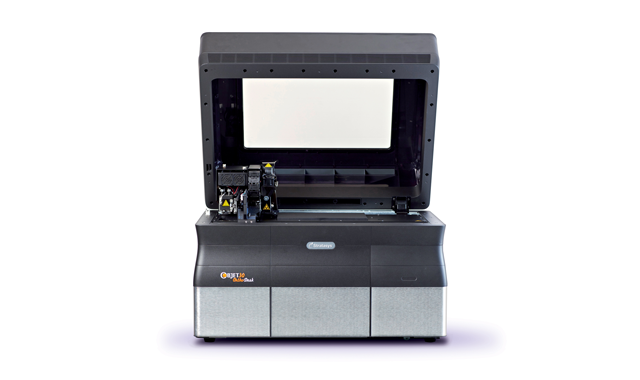
“The last thing you want to do is put a scare into a technician that they’re going to be obsolete,” Youngerman says. “I still believe there’ll always be a need for technicians that understand color and form and function and the important aspects of making a tooth. I don’t believe that a computer can completely eliminate that person.”
He adds that-like CAD/CAM-there will come a time when 3D printing is necessary for labs.
“It’s a very exciting time now with digital and watching labs make that shift,” Youngerman continues. “Early on, when we were talking about milling units and scanners, there were a lot of people saying, ‘It’s just a fad,’ ‘It’s not going to last,’ ‘Nobody can afford it.’ And now we see the adoption rate going up significantly on all levels of digital, for all laboratories. And I really believe that, as time goes on, for a laboratory to compete and be part of our industry, they’ll be forced to go digital. There’s no option there.”
Effect on doctors
For doctors, 3D printing promises the chance to produce restorations right in the office-but that won’t happen for quite a while. The technology needs to be developed and perfected before it’s used on patients.
“I can see-just like CAD/CAM-at some point in the future that it’s going to be an in-office kind of thing, it’s just getting to that point that the materials are reliable and all of that,” Dr. Flucke says.
When we finally get to the point where 3D printers are in clinical setting, Dr. Flucke expects them to be very naturally integrated.
“From the standpoint of adoption into the industry, I don’t think it will be that big a deal,” Dr. Flucke says. “In fact it might be easier, and maybe less expensive, depending on how it all pans out.”
In the end, he does expect that 3D printers will be widely adopted, but we’re not there yet.
“That’s one of the big things that I’m really excited about,” Dr. Flucke says. “They can print ridiculous things now, I just haven’t seen anything yet that they can print that is actually printable and available to go in the mouth, long-term, as far as light printable porcelain or some kind of white material that we can make teeth out of. I know that they can print metals and all kinds of things like that. I know there are people working on printing partial denture frames, and that’s phenomenal to me, but I think the really big adoption thing is when we get printable esthetic material.”
Models can be created in a variety of colors and materials. (Photo courtesy of Whip Mix Corporation)
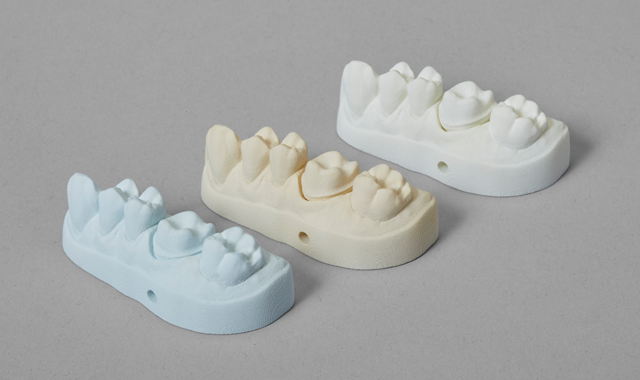
Specialists are already taking advantage of the benefits of 3D printing.
“Currently, creating 3D printed models to make clear aligners are allowing orthodontists to straighten teeth more quickly and esthetically than ever before,” Dinh says. “In the future, we can expect advances in 3D printing technology to improve orthodontists’ lives by streamlining processes and creating better products.”
Like general dentists, specialists will also benefit from future advancements.
“More digital will, of course, mean less stone and more printing,” Dr. Moody says. “I could see the day where stone is a thing of the past. From my world, which is only dental implants, I could see the ability to produce PMMA, like full arch restorations, that combine custom-shaded teeth with custom-shaded gingival material.”
Working together
One of the benefits of intraoral scanning and CAD/CAM is a tighter collaboration between clinician and lab. 3D printing is expected not only to take advantage of that feature, but also build on it, especially in terms of production speed.
“I think it’s going to speed things up,” Dr. Flucke observes. “From what I understand, 3D printing materials are going to be easier than CAD/CAM and a whole lot easier than doing things by hand. Tons and tons of stuff now becomes more automated in the lab world. What I’m hoping is, even if you don’t want to do it in the office, that your ability to send something in and then get it back in less time will be one of the pieces of this.”
“One thing it’s already doing right now is speeding up the process,” Frye adds. “Over the next few years, you’ll continue to see labs and clinics hopefully working hand-in-hand. The digital workflow only increases the communication between the lab and the clinic. That will continue, and then we’ll have to see where the materials and the printers go for the next five-to-10 years and how that impacts communication and workflow.”
At an even higher level, Azzara believes that 3D printing can help harmonize the complex interrelationship of doctors, specialists and labs.
“It helps to maximize the whole digital workflow,” Azzara observes. “A 3D printer can be deployed in a laboratory. It can be deployed in the specialist’s office. That digital file, that information, can transfer to anyplace that it needs to be, whether it be the lab, the restoring dentist, or the specialist. For instance, with a surgical guide, it’s possible for a lab to help design that guide, and then either a specialist or lab or the restoring dentist can print out the temporary for the case, or print out the guide, wherever it would be most effective and efficient within their workflow and to accommodate the patient. I think that the printer, deployed appropriately, managed between the dentist, the specialist and lab, can really help to deliver a higher standard of care that’s quicker, more effective and more efficient than we have today. And it helps to pull the pieces of this digital puzzle together, where the digital information can transfer from one person to the other. But the manufacturing of the device can be done where it’s most efficient to be done. Some of the devices might be in the clinical setting. Sometimes it might be done in the laboratory. It doesn’t mean that the laboratory has to be excluded from this. In fact, I think it’s a great opportunity for the lab to direct this happening.”
While 3D printing may blur lines between doctors, specialists and labs, Youngerman observes that everyone still has their role.
“I think dentists still make their money being chairside,” Youngerman says. “Not making restorations, not fabricating restorations. As a long-term solution, you’ll probably see more engagement of dental labs partnering with dentists in that capacity. Maybe it’s a very large clinic and there’s a lab on site. I think the average dentist that wants to work with the lab will do it through a digital file, and I don’t see that changing anytime soon. We can see the growth in digital impressioning happening very rapidly now, especially with the availability of these 3D printers, as they become more and more affordable for the laboratory and they embrace it, it’s opening up huge revenue opportunities, at least initially. The early adopters are benefiting from the investment. Because they’re investing, more doctors are investing in intraoral scanners.”
3D printing can already produce impressive devices, tools and components for labs and doctors alike. The future only looks brighter, not only for the products that will be possible, but also to create efficiencies in workflows.
Top photo courtesy of Whip Mix Corporation.
Product Bites – January 19, 2024
January 19th 2024Product Bites makes sure you don't miss the next innovation for your practice. This week's Product Bites podcast features new launches from Adravision, Formlabs, Owandy Radiology, Henry Schein Orthodontics, Dental Creations, and Dental Blue Box. [5 Minutes]
Product Bites – December 22, 2023
December 22nd 2023The weekly new products podcast from Dental Products Report is back. With a quick look at all of the newest dental product launches, Product Bites makes sure you don't miss the next innovation for your practice. This week's Product Bites podcast features updated software from Medit. [2 Minutes]